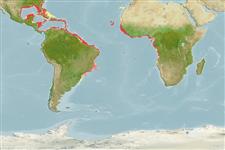Common names from other countries
Environment: milieu / climate zone / depth range / distribution range
Ecologia
marino associati a barriera corallina; distribuzione batimetrica 1 - 70 m (Ref. 58047), usually 2 - 35 m (Ref. 40849). Tropical; 33°N - 35°S, 98°W - 19°E
Western Atlantic: Bermuda and southern Florida, USA to Brazil. Eastern Atlantic: Mauritania to Angola, including St. Paul's Rocks (Ref. 13121), Cape Verde, St. Helena and Ascension islands. One record from Cape of Good Hope, South Africa (Ref. 7320).
Size / Peso / Age
Maturity: Lm ? range ? - ? cm
Max length : 35.0 cm TL maschio/sesso non determinato; (Ref. 26999); common length : 25.0 cm TL maschio/sesso non determinato; (Ref. 3632)
Spine dorsali (totale): 3; Raggi dorsali molli (totale): 23-25. Pale spots about the size of the pupil or smaller on body and some on dorsal fin (Ref. 13442).
Maximum depth from Ref. 126840. A solitary species (Ref. 26340) inhabiting shallow water on bottoms with eroded limestone or mixed sand and rocks, as well as around reefs. Often found lying motionless against rocks (Ref. 13121). Secretes copious mucus which makes its surface slimy and when disturbed the slime turns into a soapy foam. The mucus has been shown to contain a toxic protein (Ref. 3632). Nocturnal, frequently seen around the bases of coral colonies and near mouths of caves (Ref. 26938).
Life cycle and mating behavior
Maturità | Riproduzione | Deposizione | Uova | Fecundity | Larve
Robins, C.R. and G.C. Ray, 1986. A field guide to Atlantic coast fishes of North America. Houghton Mifflin Company, Boston, U.S.A. 354 p. (Ref. 7251)
IUCN Red List Status (Ref. 130435)
CITES (Ref. 128078)
Not Evaluated
Human uses
Pesca: pesca di sussistenza; Acquario: Commerciale
Informazioni ulteriori
BibliografiaAcquacolturaProfilo di acquacolturaVarietàGeneticaElectrophoresesEreditarietàMalattieElaborazioneMass conversion
Strumenti
Special reports
Download XML
Fonti Internet
Estimates based on models
Preferred temperature (Ref.
115969): 23.4 - 28, mean 26.5 (based on 708 cells).
Phylogenetic diversity index (Ref.
82804): PD
50 = 0.5010 [Uniqueness, from 0.5 = low to 2.0 = high].
Bayesian length-weight: a=0.01148 (0.00451 - 0.02922), b=3.06 (2.84 - 3.28), in cm Total Length, based on LWR estimates for this (Sub)family-body shape (Ref.
93245).
Trophic level (Ref.
69278): 4.1 ±0.5 se; based on diet studies.
Fishing Vulnerability (Ref.
59153): Low vulnerability (25 of 100).
